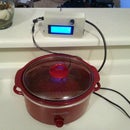Introduction: Two-tone Laser Etched Stainless Water Bottles
My friend had a birthday recently and his girlfriend wanted to make custom water bottles for him and all his friends. I immediately volunteered, since it means I get to use the LASER CUTTER!!!
For the materials, we used stainless steel bottles from Amazon:
http://www.amazon.com/dp/B002VD2RGO/ref=pe_175190_21431760_M3T1_ST1_dp_1
We tried Blue, Black, Orange, Green, and Red. Personally, I think the green one came out the best, but you can see for yourself.
I made it at Techshop using the 45W Epilog Helix and rotary attachment!
Step 1: The Image
I used Adobe Illustrator for this. A lot of people like to use Coreldraw. Pick your poison.
The way that the rotary attachment works on the Epilog laser cutters has the piece sitting sideways in the machine. Therefore, the x-axis is the height of the area you want to print and the y-axis is the circumference of the piece. This also means that when you make your artwork, you are going to have to rotate it (assuming you want it to align properly when the bottle is sitting upright!
Since my art doesn't go quite all the way around, I didn't worry about being super precise when measuring the bottle.
I've attached the artwork in .eps so you can take a look in illustrator or coreldraw if you'd like.
You'll notice that my artwork is two-toned. I wasn't sure this was going to work at first, but it turned out, it created a great effect if you get the settings right!
For the wording effect, I created the text, then rotated each word individually to get it the way I wanted. Then I copied each word into a new layer, changed the color to a light grey (C=0, M=0, Y=0, K=20), and rotated each word again to get the effect I wanted. Then I merged all of the main words into one layer, and all of the "shadow" words into a separate layer.
Attachments
Step 2: The Laser!
Hopefully you've learned how to use the rotary attachment. Basically, here's how it works:
Turn the machine off and remove the flat bed and the center divider.
Place the rotary attachment into the alignment holes, and plug in the connector to the back panel.
Turn the machine on. Tada!
Set your focus with the focus tool, just like you would on a flat piece. You can also set the home position, but you only need to adjust the x-axis.
For the laser settings, this is what worked for me to get the two-tone effect to come out.
DPS = 300
Raster Only
Speed = 60 (remember, don't go faster than this unless your piece is really tall - to avoid blowing out the motors!)
Power = 40
Floyd Steinburg dithering (probably not that important for this job...)
Don't forget to make sure your piece size matches your artwork!
To get the settings right, for the first pass I would suggest to set the power really low (like 10%), and print only the "shadows" layer (by hiding the other layers). Then, send the job to the laser and adjust the power on the fly until you get the outcome you want. The idea is to laser through some of the paint, but not all the way through to the metal (your other layers will go all the way through to the metal, and that's how you will achieve the two-tone effect).














